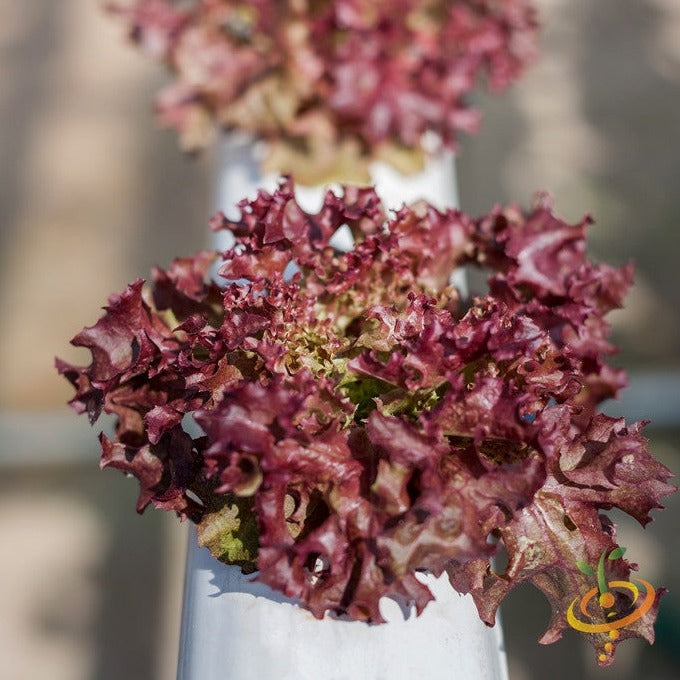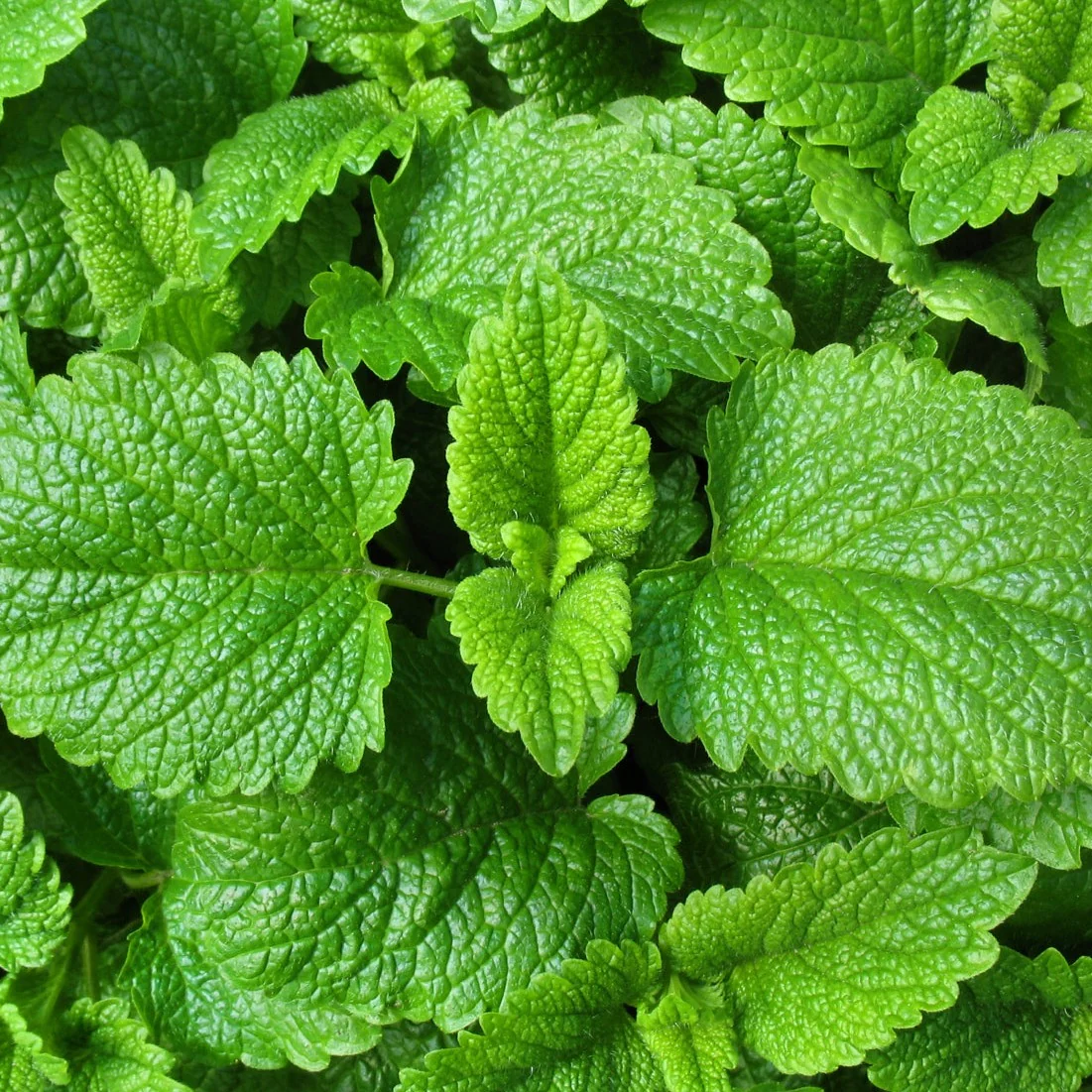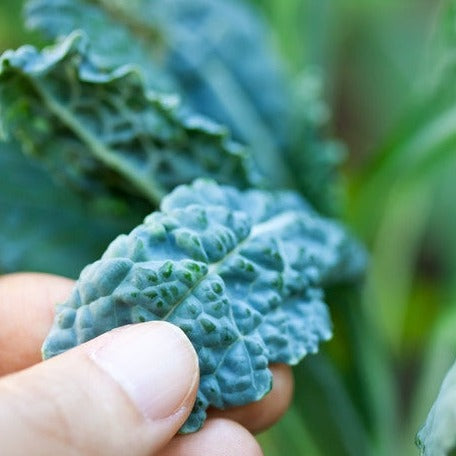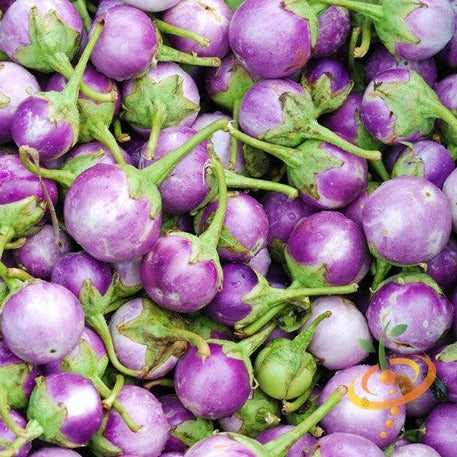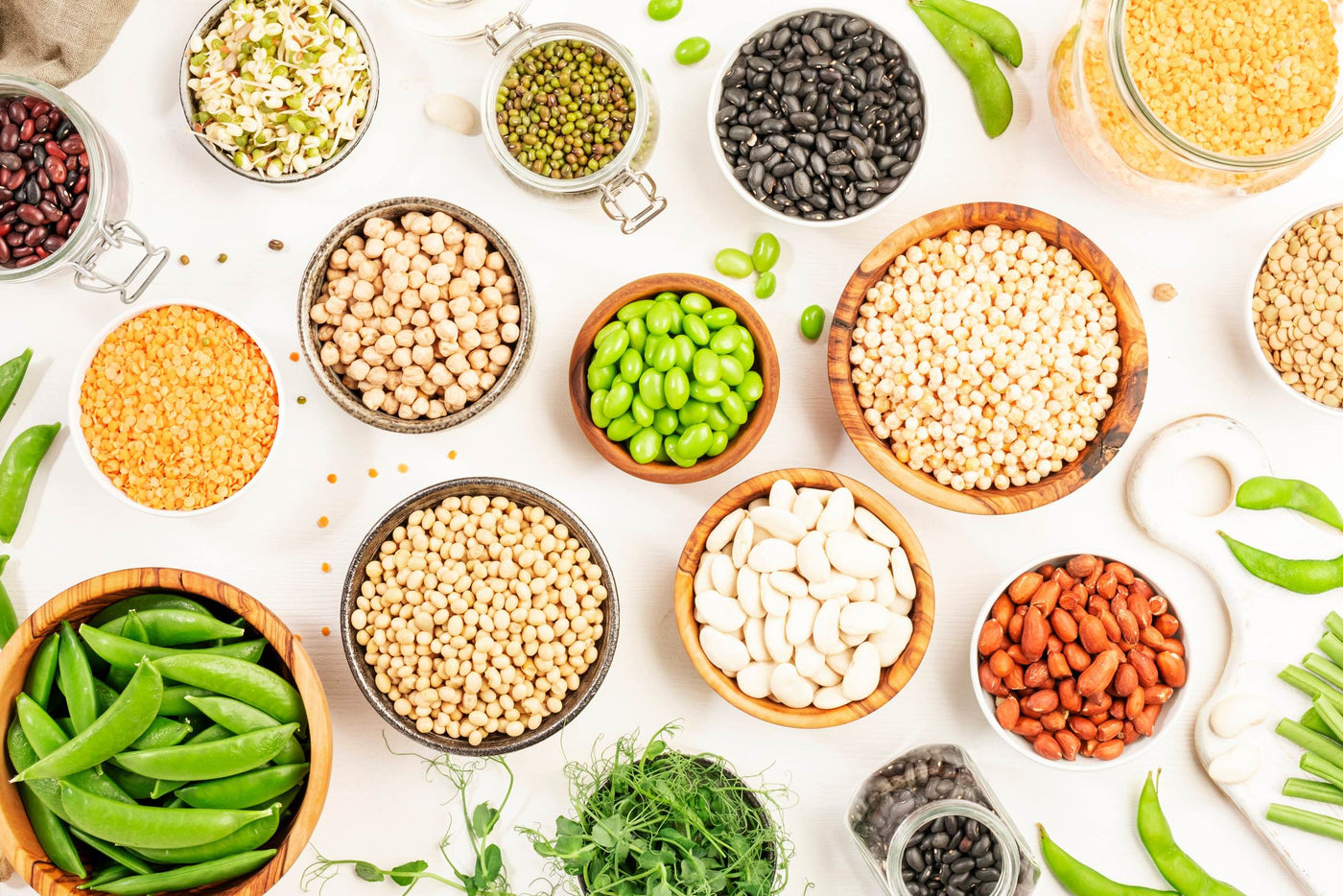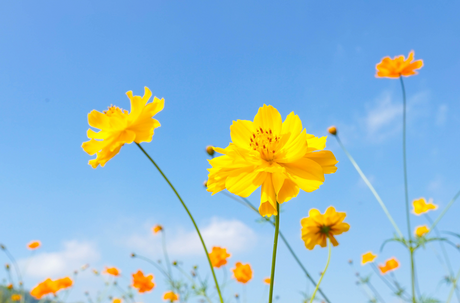Lettuce - Salad Bowl, Red seeds
From $399 USDUnit price /UnavailableDescription

- The Red Salad Bowl Mix is a really easy-to-grow lettuce variety
- Extremely flavorful red leafs
- Continues to grow as picked. As outer leaves are picked, inner leaves keep growing
- Excellent addition for salads and garnishes -
Days to Maturity | 45 days
-
Lettuce Seeds | Lettuce can be grown practically anywhere. For leaf types seed should be sown thinly in rows 1 foot apart. For head, Bibb, and cos types, space rows 18 inches apart.
Click here for complete Lettuce grow guide
- The Red Salad Bowl Mix is a really easy-to-grow lettuce variety
Lettuce - Salad Bowl, Green seeds
From $399 USDUnit price /UnavailableDescription

- The Green Salad Bowl Mix is a really easy-to-grow lettuce variety
- Extremely flavorful green leafs
- Continues to grow as picked. As outer leaves are picked, inner leaves keep growing
- Excellent addition for salads and garnishes -
Days to Maturity | 45 days
-
Lettuce Seeds | Lettuce can be grown practically anywhere. For leaf types seed should be sown thinly in rows 1 foot apart. For head, Bibb, and cos types, space rows 18 inches apart.
Click here for complete Lettuce grow guide
- The Green Salad Bowl Mix is a really easy-to-grow lettuce variety
- From $399 USDUnit price /Unavailable
Description

- Extremely easy to grow! Produces good yields of romaine lettuce with red tips
- A great variety for gourmet dishes
-
Days to Maturity | 45 days
-
Lettuce Seeds | Lettuce can be grown practically anywhere. For leaf types seed should be sown thinly in rows 1 foot apart. For head, Bibb, and cos types, space rows 18 inches apart.
Click here for complete Lettuce grow guide
Lettuce - Romaine, Dark Green seeds
From $399 USDUnit price /UnavailableDescription

- The Green Cos (aka Romaine Lettuce) is one of the most popular crispy salad vegetables
- This variety of lettuce is well known for its crisp green upright narrow heads of leaf that comes in dark green color
- Also grows well in containers on a patio
- Contains the most nutrients
- Used in Cesar Salads.
-
Days to Maturity | 65 days
-
Lettuce Seeds | Lettuce can be grown practically anywhere. For leaf types seed should be sown thinly in rows 1 foot apart. For head, Bibb, and cos types, space rows 18 inches apart.
Click here for complete Lettuce grow guide
- The Green Cos (aka Romaine Lettuce) is one of the most popular crispy salad vegetables
Lettuce - Romaine, Classic "Paris Island Cos" seeds
From $399 USDUnit price /UnavailableDescription

- Large, upright, full-bodied heads with dark-green, slightly savoyed leaves that are mild and sweet
- Plant reaches about 10 inches tall. Midribs are crunchy and juicy
- Because of their higher chlorophyll content, romaine lettuces are among the most nutritious of all lettuces
- Excellent performer in the inter-mountain region. Mosaic tolerant
-
Days to Maturity | 80 days
-
Lettuce Seeds | Lettuce can be grown practically anywhere. For leaf types seed should be sown thinly in rows 1 foot apart. For head, Bibb, and cos types, space rows 18 inches apart.
Click here for complete Lettuce grow guide
- Large, upright, full-bodied heads with dark-green, slightly savoyed leaves that are mild and sweet
- From $399 USDUnit price /Unavailable
Description

- Beautiful red lettuce leaves
- Curly leaves with really nice texture and color
- Extremely popular amongst gourmet chefs and restaurants
- Easy to grow and does not require a lot of space
-
Days to Maturity | 50 days
-
Lettuce Seeds | Lettuce can be grown practically anywhere. For leaf types seed should be sown thinly in rows 1 foot apart. For head, Bibb, and cos types, space rows 18 inches apart.
Click here for complete Lettuce grow guide
- Beautiful red lettuce leaves
- From $399 USDUnit price /Unavailable
Description

- Beautiful bright lime green lettuce leaves
- This is the green alternative to Lollo Rossa
- Compact and curly with amazing flavor
- Extremely popular amongst gourmet chefs and restaurants
- Easy to grow and does not require a lot of space
-
Days to Maturity | 50 days
-
Lettuce Seeds | Lettuce can be grown practically anywhere. For leaf types seed should be sown thinly in rows 1 foot apart. For head, Bibb, and cos types, space rows 18 inches apart.
Click here for complete Lettuce grow guide
- Beautiful bright lime green lettuce leaves
- From $399 USDUnit price /Unavailable
Description

- Little Gem Lettuce is a compact, crisp romaine variety prized for its sweet flavor and exceptional heat tolerance. Growing to just 6-8 inches tall, it forms dense, tightly-wrapped heads with crunchy, juicy leaves. This space-efficient cultivar matures quickly (typically 55-65 days) and performs well in containers or small garden spaces. Plant successively for continuous harvests throughout the growing season.
- Crisp & refreshing, sweet & crunchy lettuce variety.
- The leaves of this particular lettuce makes it idea for use in wraps and hors d'oeuvres.
- Easy to grow in compact spaces and smaller containers.
-
Days to Maturity | 65 days
-
Lettuce Seeds | Lettuce can be grown practically anywhere. For leaf types seed should be sown thinly in rows 1 foot apart. For head, Bibb, and cos types, space rows 18 inches apart.
Click here for complete Lettuce grow guide
- Little Gem Lettuce is a compact, crisp romaine variety prized for its sweet flavor and exceptional heat tolerance. Growing to just 6-8 inches tall, it forms dense, tightly-wrapped heads with crunchy, juicy leaves. This space-efficient cultivar matures quickly (typically 55-65 days) and performs well in containers or small garden spaces. Plant successively for continuous harvests throughout the growing season.
- From $399 USDUnit price /Unavailable
Description

- Iceberg lettuce is most often grown as a leaf vegetable
- Mild in flavor, it has been described over the centuries as a cooling counterbalance to other ingredients in a salad
-
Days to Maturity | 45 days
-
Lettuce Seeds | Lettuce can be grown practically anywhere. For leaf types seed should be sown thinly in rows 1 foot apart. For head, Bibb, and cos types, space rows 18 inches apart.
Click here for complete Lettuce grow guide
- From $399 USDUnit price /Unavailable
Description

- Flavorful dark green crinkled lettuce
- Chef's all around the country grow this variety to include in salads and garnishes
- Very popular and easy to grow from seed
- Does not require a lot of space to grow
-
Days to Maturity | 65 days
-
Lettuce Seeds | Lettuce can be grown practically anywhere. For leaf types seed should be sown thinly in rows 1 foot apart. For head, Bibb, and cos types, space rows 18 inches apart.
Click here for complete Lettuce grow guide
- Flavorful dark green crinkled lettuce
Lettuce - Gourmet/Mesclun Mix seeds
From $399 USDUnit price /UnavailableDescription

- A mixture of favorite lettuce seed varieties from across the spectrum of lettuce types
- Plant heavy and start harvest early for young for baby greens then allow some to grow on for plenty of variety for salads
- A great way to get a lot out of little space
- Perfect for container gardening
-
Days to Maturity | 35-70 days
-
Lettuce Seeds | Lettuce can be grown practically anywhere. For leaf types seed should be sown thinly in rows 1 foot apart. For head, Bibb, and cos types, space rows 18 inches apart.
Click here for complete Lettuce grow guide
- A mixture of favorite lettuce seed varieties from across the spectrum of lettuce types
- From $399 USDUnit price /Unavailable
Description

-
One of the key characteristics of crisphead lettuce is its high water content, which contributes to its refreshing crunch. This variety is also low in calories, making it a healthy choice for those looking to maintain a balanced diet. In addition, crisphead lettuce is a good source of vitamins A and K, as well as folate.
-
Crisphead lettuce is a type of compact butterhead lettuce that forms tight, dense heads. This variety is popular for its crisp texture and mild flavor, making it a versatile option for salads, sandwiches, and wraps.
-
Day to Maturity | 65 days
-
Lettuce Seeds | Lettuce can be grown practically anywhere. For leaf types seed should be sown thinly in rows 1 foot apart. For head, Bibb, and cos types, space rows 18 inches apart.
Click here for complete Lettuce grow guide
-
- From $399 USDUnit price /Unavailable
Description
- Compact butterhead-type lettuce
- Very productive variety
- One of the only heat tolerant lettuce varieties
- Very popular and easy to grow
-
Days to Maturity | 65 days
-
Lettuce Seeds | Lettuce can be grown practically anywhere. For leaf types seed should be sown thinly in rows 1 foot apart. For head, Bibb, and cos types, space rows 18 inches apart.
Click here for complete Lettuce grow guide
- Compact butterhead-type lettuce
Lettuce - Burgundy Boston seeds
From $399 USDUnit price /UnavailableDescription
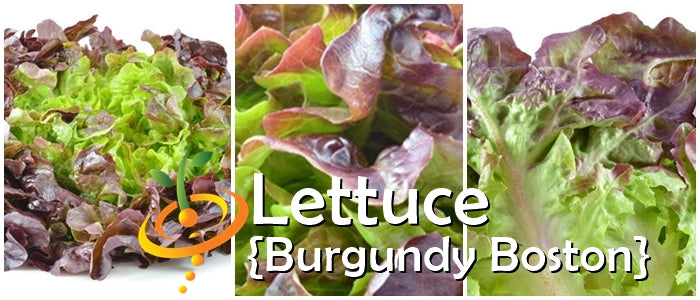
- Beautiful multi-color lettuce leaves
- Semi-curly leaves with really nice texture and color
- Extremely popular amongst gourmet chefs and restaurants
- Easy to grow and does not require a lot of space
-
Days to Maturity | 70 days
-
Lettuce Seeds | Lettuce can be grown practically anywhere. For leaf types seed should be sown thinly in rows 1 foot apart. For head, Bibb, and cos types, space rows 18 inches apart.
Click here for complete Lettuce grow guide
- Beautiful multi-color lettuce leaves
Lettuce - Blonde de Paris seeds
From $399 USDUnit price /UnavailableDescription

- Crisp & refreshing lettuce variety
- The leaves of this particular lettuce makes it idea for use in gourmet sandwiches, burgers and salads
-
Days to Maturity | 60 days
-
Lettuce Seeds | Lettuce can be grown practically anywhere. For leaf types seed should be sown thinly in rows 1 foot apart. For head, Bibb, and cos types, space rows 18 inches apart.
Click here for complete Lettuce grow guide
- Crisp & refreshing lettuce variety
Lettuce - Black Seeded Simpson seeds
From $399 USDUnit price /UnavailableDescription
- Easy to grow crisp leaf lettuce variety
- Grows really well in containers and tight spaces
- Perfect for hydroponic growers
- Excellent for salads and other culinary dishes
- A popular variety of lettuce for many chefs
-
Days to Maturity | 65 days
-
Lettuce Seeds | Lettuce can be grown practically anywhere. For leaf types seed should be sown thinly in rows 1 foot apart. For head, Bibb, and cos types, space rows 18 inches apart.
Click here for complete Lettuce grow guide
- Easy to grow crisp leaf lettuce variety
Lettuce - All Year Round seeds
From $399 USDUnit price /UnavailableDescription

- As its name suggests, this is a lettuce that can be gown throughout the year, though it will require protection with a cloche or cold frame in the cooler months
The 'All Year Round' lettuce is a classic Butterhead lettuce, with medium sized loosely formed heads and soft, buttery-textured green leaves
-
DayS to Maturity | 65 days
-
Lettuce Seeds | Lettuce can be grown practically anywhere. For leaf types seed should be sown thinly in rows 1 foot apart. For head, Bibb, and cos types, space rows 18 inches apart.
Click here for complete Lettuce grow guide
- As its name suggests, this is a lettuce that can be gown throughout the year, though it will require protection with a cloche or cold frame in the cooler months
- From $399 USDUnit price /Unavailable
Description

- The lemon balm plant produces beautiful lemon scented leaves
- The leaves are typically used in teas, sauces, salads, soups, stews, and drinks
- Lemon Balm tea is said to stimulate the heart and calms the nerves
- A variety native of Europe
- Perennial
- Days to Maturity | 75 days
- The lemon balm plant produces beautiful lemon scented leaves
Lavender, English Flower seeds
From $399 USDUnit price /UnavailableKohlrabi - Vienna, Purple seeds
From $399 USDUnit price /UnavailableDescription

Kohlrabi - Vienna, Purple is a vibrant vegetable prized for its crisp texture and mild, slightly sweet flavor. This variety features striking purple skin with creamy white flesh, adding both color and nutrition to your garden. Ideal for cooler seasons, Vienna Purple grows quickly and develops a compact, globe-shaped bulb that can be harvested young for tender eating or allowed to mature for a more robust taste. Its versatility makes it perfect for fresh salads, roasting, or steaming, offering gardeners a rewarding and visually appealing crop.
- Popular home garden variety
- The skin is purplish and the flesh is greenish/white
- Kohlrabi looks like a turnip growing above-ground
- These are best enjoyed when they are 2 to 2½ inches in diameter
-
Days to Maturity | 55 days
-
Kohlrabi Seeds | Grow Kohlrabi in loose, average soil. Direct-sow your seeds 4 to 6 weeks before the last frost in your growing zone; about ¼ inch deep, and 10 seeds per foot.
Click here for complete Kohlrabi grow guide
Additional Details
Kohlrabi is one of the most commonly eaten vegetables in Kashmir Locally called monj, the vegetable is eaten along with the leaves (haakh). A Kashmiri household may have this on their dinner or lunch plates three to four times a week.
Kohlrabi - Delicatesse, Blue seeds
From $399 USDUnit price /UnavailableDescription
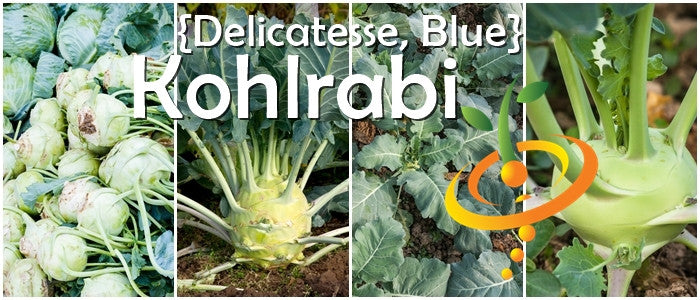
- This Kohlrabi variety produces extremely tender round bulbs
- Best to harvest when bulbs reach 4" across
- Well known for uniform size and disease resistance
- Kohlrabi looks like a turnip growing above-ground
-
Days to Maturity | 55-60 days
-
Kohlrabi Seeds | Grow Kohlrabi in loose, average soil. Direct-sow your seeds 4 to 6 weeks before the last frost in your growing zone; about ¼ inch deep, and 10 seeds per foot.
Click here for complete Kohlrabi grow guide
Kohlrabi is one of the most commonly eaten vegetables in Kashmir. Locally called monj, the vegetable is eaten along with the leaves (haakh). A Kashmiri household may have this on their dinner or lunch plates three to four times a week.
- This Kohlrabi variety produces extremely tender round bulbs
- From $399 USDUnit price /Unavailable
Description

-
Early Kale variety produces flavorful leaves
- The blue-green leaves are finely curled and reach up to 12-15" tall
- Can handle the cold extremely well
- One of the best frost resistant kale varieties available
-
Days to Maturity | 65 days
-
Kale Seeds | Kale can be planted pretty much anywhere in the United States where there's a cool fall growing season. Plant Kale in rows 18 inches to 2 feet apart.
Click here for complete Kale grow guide
Additional Details
Kale is considered to be a highly nutritious vegetable with powerful antioxidant properties; kale is considered to be anti-inflammatory. Kale is very high in beta carotene, vitamin K, vitamin C, lutein, zeaxanthin, and reasonably rich in calcium.
Follow SeedsNow.com's board Kale on Pinterest. -
Early Kale variety produces flavorful leaves
- From $399 USDUnit price /Unavailable
Description
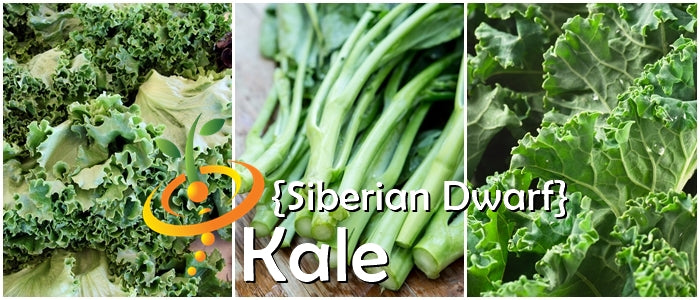
-
Early Kale variety produces flavorful leaves
- The dark-green leaves are finely curled and reach up to 8-12"
- Great when used fresh in salads or on sandwiches
- Can handle the cold extremely well
- Very good frost resistant kale variety
-
Days to Maturity | 50 days
-
Kale Seeds | Kale can be planted pretty much anywhere in the United States where there's a cool fall growing season. Plant Kale in rows 18 inches to 2 feet apart.
Click here for complete Kale grow guide
Additional DetailsKale is considered to be a highly nutritious vegetable with powerful antioxidant properties; kale is considered to be anti-inflammatory. Kale is very high in beta carotene, vitamin K, vitamin C, lutein, zeaxanthin, and reasonably rich in calcium.
Follow SeedsNow.com's board Kale on Pinterest. -
Early Kale variety produces flavorful leaves
- From $399 USDUnit price /Unavailable
Description

- Stems are purple with deep gray-green leaves.
- The plants mature medium-tall and leaves are tender compared to other kale varieties
- Ideal for salads and light cooking
- This variety is excellent producer in cooler growing seasons
-
Days to Maturity | 65 days
-
Kale Seeds | Kale can be planted pretty much anywhere in the United States where there's a cool fall growing season. Plant Kale in rows 18 inches to 2 feet apart.
- Click here for complete Kale grow guide
Additional Details
Kale is considered to be a highly nutritious vegetable with powerful antioxidant properties; kale is considered to be anti-inflammatory. Kale is very high in beta carotene, vitamin K, vitamin C, lutein, zeaxanthin, and reasonably rich in calcium.
Follow SeedsNow.com's board Kale on Pinterest.
- Stems are purple with deep gray-green leaves.
- From $399 USDUnit price /Unavailable
Description

-
Extremely flavorful Kale variety. Ideal for juicing and healthy smoothies.
- This variety will stay in the ground 3-4 weeks longer than other Kale varieties.
- Also an excellent variety for a Fall and Winter harvest!
-
Days to Maturity | 50 days
-
Kale Seeds | Kale can be planted pretty much anywhere in the United States where there's a cool fall growing season. Plant Kale in rows 18 inches to 2 feet apart.
Click here for complete Kale grow guide
Additional DetailsKale is considered to be a highly nutritious vegetable with powerful antioxidant properties; kale is considered to be anti-inflammatory. Kale is very high in beta carotene, vitamin K, vitamin C, lutein, zeaxanthin, and reasonably rich in calcium.
-
Extremely flavorful Kale variety. Ideal for juicing and healthy smoothies.
Kale - Tuscany, Lacinato "Dinosaur" seeds
From $399 USDUnit price /UnavailableDescription

- Old Italian heirloom, rather primitive open kale with blue-green strap leaves that are 3" wide by 10-18" long.
- Also know and Tuscan or Dinosaur Kale!
- Perfect for making Kale Chips!
- The leaves of this extremely winter-hardy variety become sweeter after a hard frost or harvest leaves when young and tender.
- Delicious and tender when stir-fried or steamed.
- This variety is excellent for a Fall and Winter harvest.
-
Kale is considered to be a highly nutritious vegetable with powerful antioxidant properties; kale is considered to be anti-inflammatory. Kale is very high in beta carotene, vitamin K, vitamin C, lutein, zeaxanthin, and reasonably rich in calcium.
-
Days to Maturity | 65 days
-
Kale Seeds | Kale can be planted pretty much anywhere in the United States where there's a cool fall growing season. Plant Kale in rows 18 inches to 2 feet apart.
Click here for complete Kale grow guide
Follow SeedsNow.com's board Kale on Pinterest. - Old Italian heirloom, rather primitive open kale with blue-green strap leaves that are 3" wide by 10-18" long.
Kale - Classic, Blue Curled Scotch seeds
From $399 USDUnit price /UnavailableDescription

- The Blue Curled Scotch is an early Kale variety which will produce tasty greens!
- Excellent in salads or steamed.
- The blue-green leaves are finely curled and reach up to 12-15" tall!
- Can handle the cold extremely well.
- One of the best frost resistant kale varieties available.
-
Days to Maturity | 60 days
-
Kale Seeds | Kale can be planted pretty much anywhere in the United States where there's a cool fall growing season. Plant Kale in rows 18 inches to 2 feet apart.
Click here for complete Kale grow guide
Additional Details
Kale is considered to be a highly nutritious vegetable with powerful antioxidant properties; kale is considered to be anti-inflammatory. Kale is very high in beta carotene, vitamin K, vitamin C, lutein, zeaxanthin, and reasonably rich in calcium.
- The Blue Curled Scotch is an early Kale variety which will produce tasty greens!
- From $399 USDUnit price /Unavailable
Description
Hyssop is a perennial herb prized for its aromatic, evergreen foliage and vibrant blue flowers, making it a valuable addition to any garden. It thrives in well-drained soil with full sun exposure and demonstrates excellent drought tolerance once established. Hyssop attracts beneficial pollinators such as bees and butterflies, enhancing biodiversity and supporting nearby plants. Its leaves and flowers are used for culinary purposes and traditional herbal remedies, offering both sensory and functional benefits. Cultivating hyssop requires minimal maintenance, making it ideal for gardeners seeking a resilient, multipurpose herb.
- Hyssop has a long history of medicinal use and was so highly esteemed in the past that it was considered to be a virtual cure-all.
- Day to Maturity | 75 days
Additional DetailsHyssop is a versatile herb that brings both beauty and utility to your garden. Known for its aromatic leaves and striking blue flowers, it attracts pollinators like bees and butterflies, promoting a healthy garden ecosystem. Beyond its visual appeal, hyssop can enhance your cooking with its distinctive flavor and has a history of traditional medicinal use. Easy to grow and maintain, this herb is a valuable addition for gardeners seeking a blend of charm and functionality. Add hyssop to your garden and enjoy its many benefits all season long.
"Currently an undervalued herb, it is often used as a household remedy, particularly as an expectorant and stomach tonic. It has a positive effect when used to treat bronchitis and respiratory infections, especially where there is excessive mucous production. Hyssop can irritate the mucous membranes, so it is best given after an infection has peaked, when the herb's tonic action encourages a general recovery. The plant should not be used by pregnant women, however, since in large quantities it can induce a miscarriage. The leaves and flowering tops are antiseptic, antitussive, astringent, carminative, diaphoretic, emmenagogue, expectorant, pectoral, sedative, stimulant, stomachic, tonic and vasodilator. The plant can be harvested when in full flower and dried for later use. A tea made from the leaves is used in the treatment of flatulence, stomach-aches, upper respiratory tract infections, coughs in children etc. A poultice made from the fresh herb is used to heal wounds. The essential oil is used in aromatherapy. Its keyword is 'Stability'. This oil should not be used on people who are highly strung as it can cause epileptic symptoms. The essential oil should not be used internally except under professional supervision." SOURCE
WARNING LABEL: SeedsNow.com cannot take any responsibility for any adverse effects from the use of seeds and/or plants. Always seek advice from a professional before using a seed and/or plant for medicinal purposes.
- Hyssop has a long history of medicinal use and was so highly esteemed in the past that it was considered to be a virtual cure-all.
- From $399 USDUnit price /Unavailable
Description

- The Fenugreek plant produces extremely flavorful seeds which are widely used in many Indian dishes, including Curry powder
- The green leaves are used in many Middle Eastern vegetable dishes
- Fenugreek also has a long history of being used as a medicinal herb to aid in digestion and aid in healing
- Acts as a laxactive. lubricates the intestines, and reduces fevers. Has also been shown to lower cholesterol and blood sugar levels. Helps with asthma and sinus issues by reducing mucus. Promotes lactation in nursing mothers. Good for eyes and for inflammation and lung disorders.
- Days to Maturity | 75 days
Follow SeedsNow.com's board Fenugreek on Pinterest. - From $399 USDUnit price /Unavailable
Description

-
Produces very flavorful large bulbs and edible flower buds
- Excellent for seasonings and for cooking as a vegetable
- Plant Height: 30" tall
- Fennel is a very aromatic plant with a sweet licorice flavor, similar to an anise seed. It has many medicinal uses and herbalists have been using it for centuries to relieve problems with the respiratory system, stomach muscles and intestines. Nursing mothers can expect increased milk production and fennel also has been used to soothe colicky infants.
- Fennel has a long history of herbal use and is a commonly used household remedy, being useful in the treatment of a variety of complaints, especially those of the digestive system.
- Easy to grow
- There are so many health benefits associated with this plant
-
Days to Maturity | 80 days
-
Fennel Seeds | Fennel is known as a perennial that ought to be planted sometime after the last frost of the winter. Try sowing seeds directly into your gardens, because transplanting fennel usually doesn't work very well.
Click here for complete Fennel grow guide
See Fennel Recipes & Growing Tips on our Pinterest Board
-
Produces very flavorful large bulbs and edible flower buds
Eggplant - Turkish, Orange seeds
From $399 USDUnit price /UnavailableDescription
- Solanum melongena. Plant produces good yields of tennis ball size bright orange eggplants
- Extremely flavorful
- Easy to grow
- Perfect for stuffings -
Days to Maturity | 90 days
-
Eggplant Seeds | Start seed indoors to allow at least 10 weeks for young plants to develop. Plant in rows 3 feet apart, with 2 feet between plants.
Click here for complete Eggplant grow guide
- Solanum melongena. Plant produces good yields of tennis ball size bright orange eggplants
- From $399 USDUnit price /Unavailable
Description
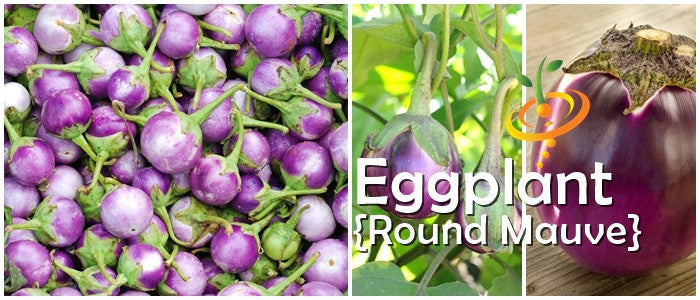
- This heirloom variety produces a beautiful round mauve eggplant with thin skin and a beautiful white flesh
- Best picked with the eggplant is the size of a tennis ball
- Perfect for container gardening
-
Days to Maturity | 80-90 days
-
Eggplant Seeds | Start seed indoors to allow at least 10 weeks for young plants to develop. Plant in rows 3 feet apart, with 2 feet between plants.
Click here for complete Eggplant grow guide
- This heirloom variety produces a beautiful round mauve eggplant with thin skin and a beautiful white flesh
Eggplant - Long Purple Italian seeds
From $399 USDUnit price /UnavailableDescription

- This all-time classic favorite eggplant produces club shaped fruits that are 10" long x 2" in diameter
- Each plant will produce four or more dark, purple fruits
-
Days to Maturity | 75 days
-
Eggplant Seeds | Start seed indoors to allow at least 10 weeks for young plants to develop. Plant in rows 3 feet apart, with 2 feet between plants.
Click here for complete Eggplant grow guide
- This all-time classic favorite eggplant produces club shaped fruits that are 10" long x 2" in diameter
Eggplant - Florida Market seeds
From $399 USDUnit price /UnavailableDescription

- This plant will produce excellent yields of dark purple eggplants in the shape of teardrops
The plants are strong and especially good for market growers
Excellent for baking, slicing, and more
-
Days to Maturity | 80-90 days
-
Eggplant Seeds | Start seed indoors to allow at least 10 weeks for young plants to develop. Plant in rows 3 feet apart, with 2 feet between plants.
Click here for complete Eggplant grow guide
- This plant will produce excellent yields of dark purple eggplants in the shape of teardrops
- From $399 USDUnit price /Unavailable
Description

- This rare white heirloom eggplant variety produces ivory-white skinned eggplant and is a very early producer of 5-6 inch long fruit
- The flesh of this eggplant is snow white
- It has a succulent mushroom-like flavor that is absolutely delicious!
-
Days to Maturity | 70 days
-
Eggplant Seeds | Start seed indoors to allow at least 10 weeks for young plants to develop. Plant in rows 3 feet apart, with 2 feet between plants.
Click here for complete Eggplant grow guide
- This rare white heirloom eggplant variety produces ivory-white skinned eggplant and is a very early producer of 5-6 inch long fruit
- From $399 USDUnit price /Unavailable
Description

- Fruits are a deep-purple, egg-shaped globe about 6 by 5 inches
- Flesh is smooth, creamy and pale yellow
-
Days to Maturity | 80 days
-
Eggplant Seeds | Start seed indoors to allow at least 10 weeks for young plants to develop. Plant in rows 3 feet apart, with 2 feet between plants.
Click here for complete Eggplant grow guide
- Fruits are a deep-purple, egg-shaped globe about 6 by 5 inches
- From $399 USDUnit price /Unavailable
Description

- Annual
- 3 ft. plant with strongly aromatic foliage, stems, and heads. Excellent for pickling
- Days to Maturity | 65 days
Additional Details
Dill has a very long history of herbal use going back more than 2,000 years. The seeds are a common and very effective household remedy for a wide range of digestive problems. An infusion is especially efficacious in treating gripe in babies and flatulence in young children. The seed is aromatic, carminative, mildly diuretic, galactogogue, stimulant and stomachic.
Other Medicinal Properties
Dill is also used in the form of an extracted essential oil. Used either in an infusion, or by eating the seed whole, the essential oil in the seed relieves intestinal spasms and griping, helping to settle colic. Chewing the seed improves bad breath. Dill is also a useful addition to cough, cold and flu remedies, it can be used with antispasmodics such as Viburnum opulus to relieve period pains. Dill will also help to increase the flow of milk in nursing mothers and will then be taken by the baby in the milk to help prevent colic.
See Dill Recipes & Growing Tips on our Pinterest Board
Follow SeedsNow.com's board Dill on Pinterest. - Annual
- From $399 USDUnit price /Unavailable
Description
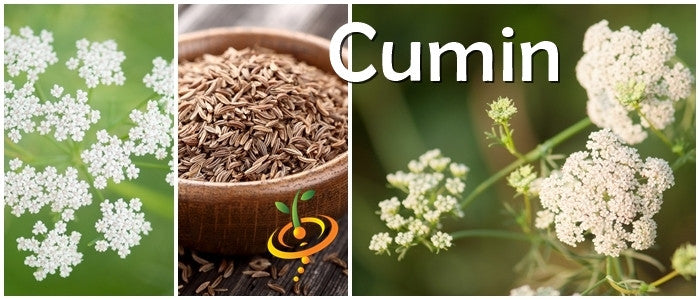
Cumin is an aromatic herb with feathery foliage and small pinkish flowers. The seeds are used as a spice, both whole and powdered, and is second only to black pepper as the most popular spice across all continents. Its earthy, nutty, slightly bitter flavor is used extensively in traditional North African, Indian, and Mexican cuisines. Thrives in hot, dry conditions. The leaves and flowers are also edible, and can be used to add unique flavor to salads and pickling brines.
- Earthy, nutty, flavor
- Heat and drought tolerant
- Grows 8"-12" tall
- Good for containers
As a companion plant, it attracts pollinators and beneficial insects.
As a medicinal herb, Cumin seed has been used internally to treat bloating, colic, cough, fever, flatulence, headache, indigestion, insomnia, pain, restlessness, stomach upset, and weight issues, and externally to treat skin problems and toothache.
SEED PLANTING TIPS
- Botanical name: Cuminum cyminum
- Life cycle: Herbaceous annual
- Hardiness zones: 5-10
- Planting season: Spring
- Days to maturity: 120-150 days; can begin harvesting when 6" tall
- Depth to plant seeds: 1/4" deep
- Days to germinate (sprout): 7-14 days
- Germination soil temps: 68F-86F
- Spacing between plants: 4"-6" apart
- Spacing between rows: 18"-24" apart
- # of plants per sq. ft.: Appx. 9 plants per sq. ft.
- Soil types: Sandy, loamy, rich, dry, moist, well-drained
- Soil pH: 6.5-8.0
- Sun needs: Full sun
- Water needs: Low - do not overwater
- Cold stratify: No
- Frost tolerant: No
- Heat tolerant: Yes
- Drought tolerant: Yes
- Deer resistant: Yes
- Culinary use: Yes
- Medicinal use: Yes
⚠️ Medicinal properties are presented as information only, and are not a recommendation or prescription for use. Consult a medical professional before using any herb medicinally.
See Cumin Recipes & Growing Tips on our Pinterest Board
Follow SeedsNow.com's board Cumin on Pinterest. Cucumber - Armenian, White (Metki Serpent Melon) seeds
From $399 USDUnit price /UnavailableDescription
- These Armenian cucumber seeds will produce delicious white cucumbers as long as 30"!
- Bitter-free with excellent flavor
-
Excellent slicer and ideal for salads and many culinary dishes
- Easy to grow
-
Days to Maturity | 65 days
-
Cucumber Seeds | Grow cucumbers where a long, warm growing season, minimum 65 days, can be assured. Plant seeds where there is ample space and vines can sprawl, the simplest way is to plant cucumbers in hills.
Click here for complete Cucumber grow guide
- These Armenian cucumber seeds will produce delicious white cucumbers as long as 30"!
- From $399 USDUnit price /Unavailable
Description

- Extremely tender, medium green leaves are broad and slightly crumpled
- The juicy leaves have a mild cabbage-like flavor and are delicious boiled, steamed, or as an addition to salads
- Tolerant of heat and cold
- Rich in vitamins and minerals
- Plant grows to about 36" tall
-
Days to Maturity | 80 days
-
Collards | Plant seeds 3 to 4 weeks before your first frost for Spring harvest. Sow seeds approximately 12" from one another.
Click here for complete Collards grow guide
Additional Details
Collard is widely considered to be a healthy food, collards are good sources of vitamin C and soluble fiber and contain multiple nutrients with potent anti-cancer properties, such as diindolylmethane and sulforaphane.[citation needed] Roughly a quarter pound (approx. 100 g) of cooked collards contains 46 calories.
- Extremely tender, medium green leaves are broad and slightly crumpled
Collard - Morris Heading seeds
From $399 USDUnit price /UnavailableDescription

- Extremely tender, medium green leaves are broad and slightly crumpled
- Compact plant forming loose heads of short steamed leaves
- Tolerant of heat and cold and very rich in vitamins and minerals
- The juicy leaves have a mild cabbage-like flavor and are delicious boiled, steamed, or as an addition to salads. 36 inches tall
-
Days to Maturity | 80 days
-
Collards | Plant seeds 3 to 4 weeks before your first frost for Spring harvest. Sow seeds approximately 12" from one another.
Click here for complete Collards grow guide
Additional Details
Collard is widely considered to be a healthy food, collards are good sources of vitamin C and soluble fiber and contain multiple nutrients with potent anti-cancer properties, such as diindolylmethane and sulforaphane.[citation needed] Roughly a quarter pound (approx. 100 g) of cooked collards contains 46 calories.
- Extremely tender, medium green leaves are broad and slightly crumpled
Collard - Georgia Southern seeds
From $399 USDUnit price /UnavailableDescription

- This is the traditional Collard Green variety popularly grown in the south
- These plants produce large yields of dark blue-green cabbage-like leaves
- Tolerates heat, humidity, and poor soil conditions
-
Days to Maturity | 75 day
-
Collards | Plant seeds 3 to 4 weeks before your first frost for Spring harvest. Sow seeds approximately 12" from one another.
Click here for complete Collards grow guide
Additional Details
Collard is widely considered to be a healthy food, collards are good sources of vitamin C and soluble fiber and contain multiple nutrients with potent anti-cancer properties, such as diindolylmethane and sulforaphane.[citation needed] Roughly a quarter pound (approx. 100 g) of cooked collards contains 46 calories.
- This is the traditional Collard Green variety popularly grown in the south
- From $399 USDUnit price /Unavailable
Description

Chives (Allium schoenoprasum) are a versatile perennial allium that delivers delicate onion flavor to culinary applications. This hardy herb establishes quickly in garden beds or containers, preferring full sun and moderately fertile, well-draining soil. Chives produce attractive purple-pink flower clusters that bloom throughout spring and summer, offering ornamental appeal alongside culinary utility. Continuous harvesting encourages bushier growth and extends productivity across multiple seasons. The plant's shallow root system makes it an excellent companion in vegetable gardens, and its pungent foliage naturally repels certain garden pests. Exceptionally cold-hardy and drought-tolerant once established, chives require minimal maintenance while providing consistent harvests for soups, salads, and garnishes. An indispensable addition for any edible garden.
- Also known as Allium Scoenoprasum. A perennial plant that grows narrow, grass-like leaves that have a mild onion-like flavor
- Chives are rich in vitamins A and C, contain trace amounts of sulfur, and are rich in calcium and iron
- Used for many culinary creations
- Perfect for containers and small spaces
- The plant will grow to about 12" tall
-
Days to Maturity | 80 days
-
Chives | Chives are grown best in cooler weather, are cold hardy and usually are planted early in the spring. Sow your chive seeds directly into the soil as soon as it is workable and at least 60 degrees F.
Click here for complete Chives grow guide
If you like Chives, try growing Scallions.
See Chive Recipes & Growing Tips on our Pinterest Board
Follow SeedsNow.com's board Chives on Pinterest. - Also known as Allium Scoenoprasum. A perennial plant that grows narrow, grass-like leaves that have a mild onion-like flavor
- From $399 USDUnit price /Unavailable
Description

Tendercrisp celery is a high-performing heirloom variety distinguished by its pale green, densely packed stalks and exceptional tenderness without excessive fiber. This cultivar demonstrates robust disease resistance and adapts well to varied soil compositions and climatic zones. The plants reach maturity in approximately 85 days and produce consistently sized bunches suitable for fresh market applications. Optimal results require steady moisture management, nitrogen-rich amendments, and proper spacing to facilitate adequate air movement. Ideal for gardeners seeking reliable production and superior eating quality.
- A very large type of celery with excellent flavor.
- Days to Maturity | 85-100 days
- Celery seed is usually started indoors about 10 weeks before it is time to set the plants outdoors. Plant in rows 2 feet apart; with 6 - 8 inches between plants.
Celery - Tall Utah 52-70 seeds
From $399 USDUnit price /UnavailableDescription

- Recommended by USU. Produces strong and delicious 11" - 12" tall stalks of celery
- Good heart development and strong roots
- Excellent for juicing or blending into health drinks
- Easy to grow
- Definitely worth including in any sized garden
- Days to Maturity | 100 days
- Celery Seeds | Celery seed is usually started indoors about 10 weeks before it is time to set the plants outdoors. Plant in rows 2 feet apart; with 6 - 8 inches between plants.
Click here for complete Celery grow guide.
- Recommended by USU. Produces strong and delicious 11" - 12" tall stalks of celery
- From $399 USDUnit price /Unavailable
Description

- Plant grows excellent quality stalks of celery
- Stalks are thick and heavy, but no strings
- One of the best varieties around
- Plant grows to about 30" tall
- Easy to grow
- Celery Seeds | Celery seed is usually started indoors about 10 weeks before it is time to set the plants outdoors. Plant in rows 2 feet apart; with 6 - 8 inches between plants.
Click here for complete Celery grow guide
- Plant grows excellent quality stalks of celery
Cauliflower - Snowball/Self-blanche (White) seeds
From $399 USDUnit price /UnavailableDescription

- The Self-Blanche Cauliflower produces flavorful snow ball type cauliflower
- Plant early as it stops growing when it gets hot
- The leaves curl upward and cover head to keep sun from ruining white color
-
Days to Maturity | 65 days
-
Cauliflower Seeds | Cauliflower is an annual cool-season crop, half-hardy to frost and light freezes. Plant in rows 2 1/2 to 3 feet apart, with 2 feet between plants.
Click here for complete Cauliflower grow guide
- The Self-Blanche Cauliflower produces flavorful snow ball type cauliflower
- From $399 USDUnit price /Unavailable
Description

- The Igloo Cauliflower produces snowball type white heads
- Produces large dense leaves that protect the solid white heads from frost
- Excellent variety for the cooler months
- Days to Maturity | 65-70 days
-
Cauliflower Seeds | Cauliflower is an annual cool-season crop, half-hardy to frost and light freezes. Plant in rows 2 1/2 to 3 feet apart, with 2 feet between plants.
Click here for complete Cauliflower grow guide
- From $399 USDUnit price /Unavailable
Description

- This popular broccoli variety produces a short, 24 inch plant with medium-large heads.
- Withstands cold extremely well.
- Best grows for a fall crop.
-
Days to Maturity | 85 days
- Broccoli is high in vitamin C, as well as dietary fiber; it also contains multiple nutrients with potent anti-cancer properties, such as diindolylmethane and small amounts of selenium. A single serving provides more than 30 mg of Vitamin C and a half-cup provides 52 mg of Vitamin C.
- This popular broccoli variety produces a short, 24 inch plant with medium-large heads.
Broccoli - Romanesco Italia seeds
From $399 USDUnit price /UnavailableDescription

-
Old italian heirloom variety that produces excellent yields of beautifully unique green broccoli heads.
- This is a unique Italian variety with better taste and texture than other broccoli.
- It has beautiful apple green spiraling buds and is especially well adapted to the north.
- A heirloom variety from Italy.
-
Days to Maturity | 75 days
- Broccoli is high in vitamin C, as well as dietary fiber; it also contains multiple nutrients with potent anti-cancer properties, such as diindolylmethane and small amounts of selenium. A single serving provides more than 30 mg of Vitamin C and a half-cup provides 52 mg of Vitamin C.
-
Old italian heirloom variety that produces excellent yields of beautifully unique green broccoli heads.
🌱 Featured Seed Types (A - Z)
View allcontinue shopping

